七上Units 1-4 中考英语一轮复习讲练测人教版课件(共54张PPT)
文档属性
| 名称 | 七上Units 1-4 中考英语一轮复习讲练测人教版课件(共54张PPT) |
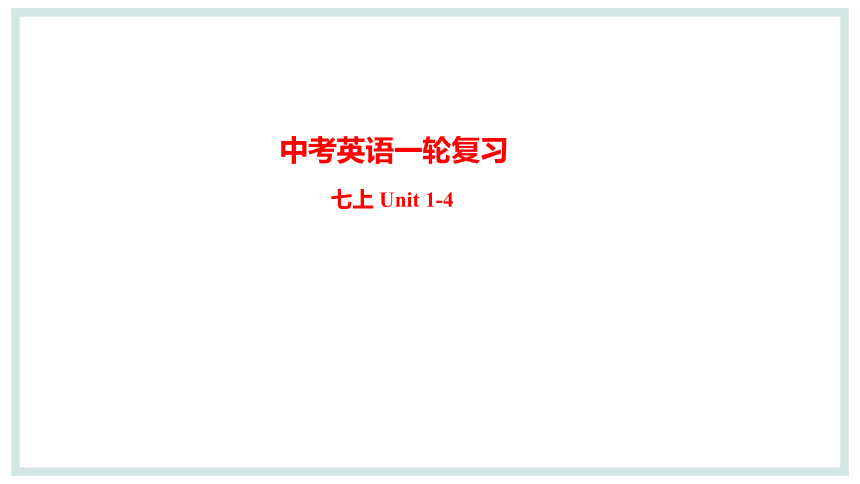
|
|
| 格式 | pptx | ||
| 文件大小 | 501.5KB | ||
| 资源类型 | 教案 | ||
| 版本资源 | 人教新目标(Go for it)版 | ||
| 科目 | 英语 | ||
| 更新时间 | 2023-11-17 08:18:49 | ||
图片预览

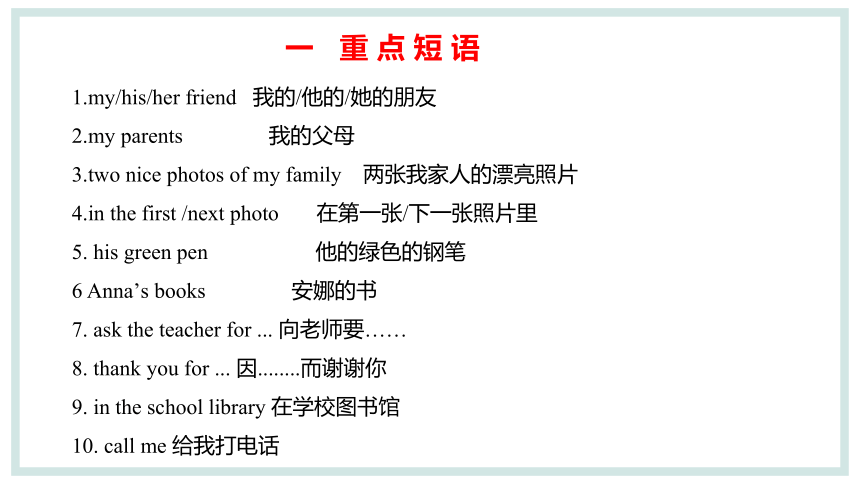
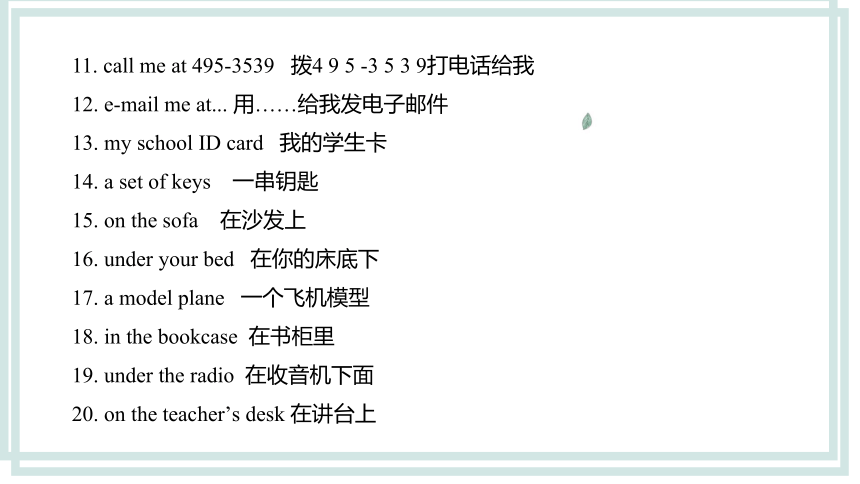
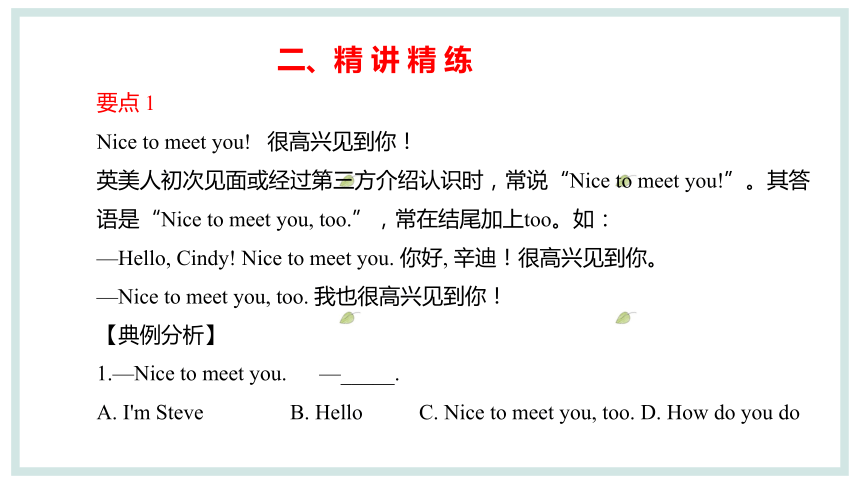
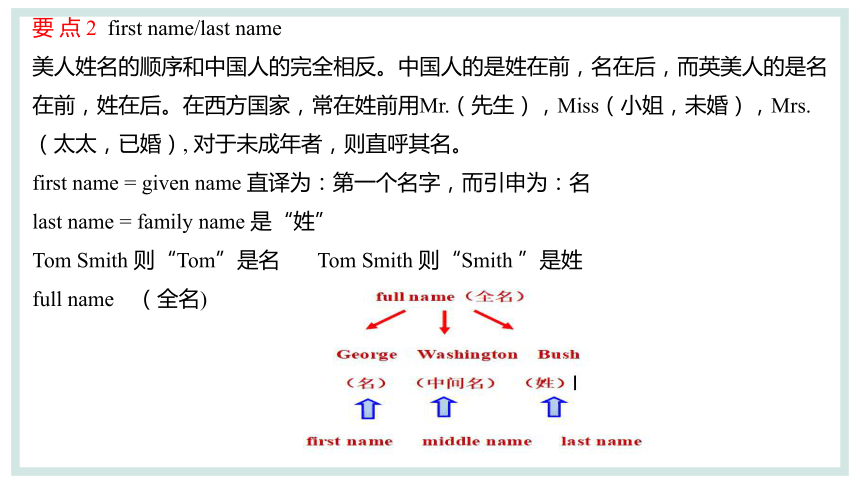

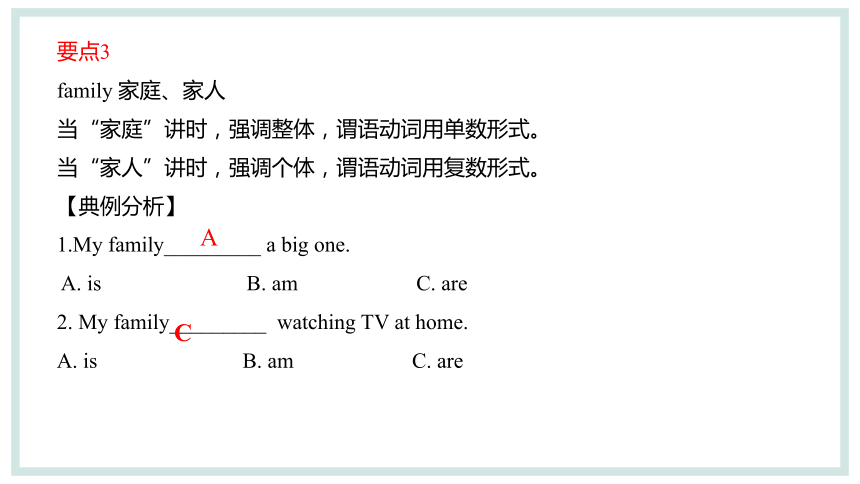
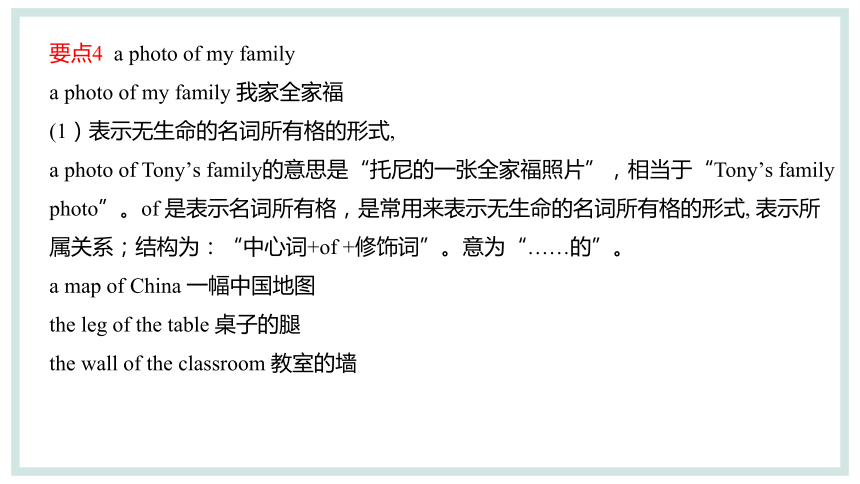
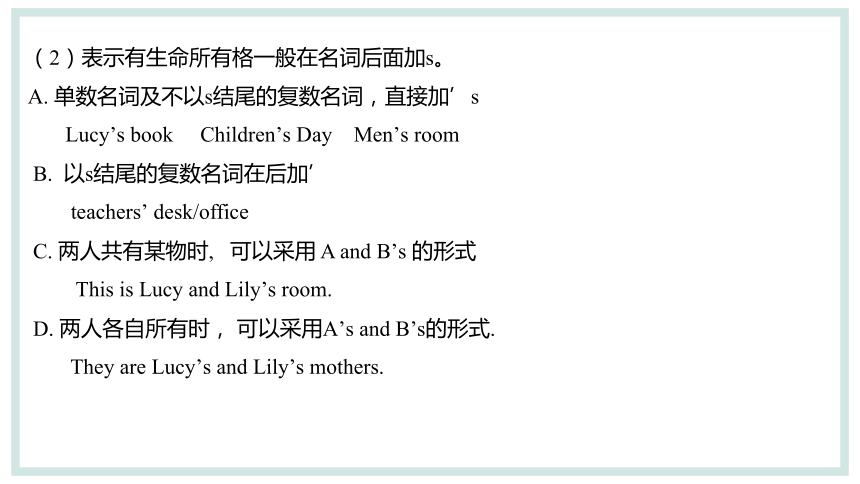


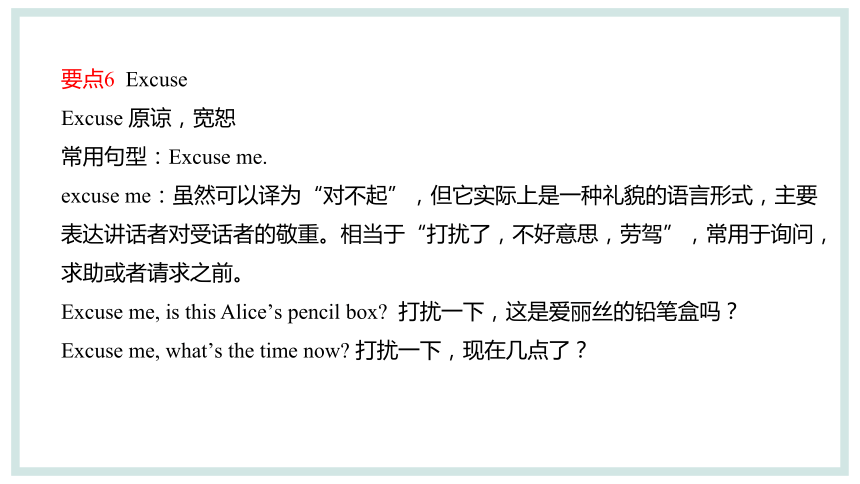
文档简介
(共54张PPT)
中考英语一轮复习
七上 Unit 1-4
一 重 点 短 语
1.my/his/her friend 我的/他的/她的朋友
2.my parents 我的父母
3.two nice photos of my family 两张我家人的漂亮照片
4.in the first /next photo 在第一张/下一张照片里
5. his green pen 他的绿色的钢笔
6 Anna’s books 安娜的书
7. ask the teacher for ... 向老师要……
8. thank you for ... 因........而谢谢你
9. in the school library 在学校图书馆
10. call me 给我打电话
11. call me at 495-3539 拨4 9 5 -3 5 3 9打电话给我
12. e-mail me at... 用……给我发电子邮件
13. my school ID card 我的学生卡
14. a set of keys 一串钥匙
15. on the sofa 在沙发上
16. under your bed 在你的床底下
17. a model plane 一个飞机模型
18. in the bookcase 在书柜里
19. under the radio 在收音机下面
20. on the teacher’s desk 在讲台上
二、精 讲 精 练
要点 1
Nice to meet you! 很高兴见到你!
英美人初次见面或经过第三方介绍认识时,常说“Nice to meet you!”。其答语是“Nice to meet you, too.”,常在结尾加上too。如:
—Hello, Cindy! Nice to meet you. 你好, 辛迪!很高兴见到你。
—Nice to meet you, too. 我也很高兴见到你!
【典例分析】
1.—Nice to meet you. —_____.
A. I'm Steve B. Hello C. Nice to meet you, too. D. How do you do
要 点 2 first name/last name
美人姓名的顺序和中国人的完全相反。中国人的是姓在前,名在后,而英美人的是名在前,姓在后。在西方国家,常在姓前用Mr.(先生),Miss(小姐,未婚),Mrs.(太太,已婚), 对于未成年者,则直呼其名。
first name = given name 直译为:第一个名字,而引申为:名
last name = family name 是“姓”
Tom Smith 则“Tom”是名 Tom Smith 则“Smith ”是姓
full name (全名)
文本信息
标题数字等都可以通过点击和重新输入进行更改。文字数字大小颜色参考此模板
【典例分析】
1. The man is David Smith. Smith is his _________ name and David is his _________ name.
A. family, first B. first, family C. first, last D. family, full
2.His name is Jim Green. ______ is his first name. ______ is his last name.
A. Jim; Green B. Green; Jim C. Jim; Jim D. Green; Green
3.他的中文名字叫邓大华,姓邓名大华,来自中国台湾。(翻译)
His Chinese name is Deng Dahua, Deng is his family name and Dahua is his given name, and he comes from Taiwan, China.
要点3
family 家庭、家人
当“家庭”讲时,强调整体,谓语动词用单数形式。
当“家人”讲时,强调个体,谓语动词用复数形式。
【典例分析】
1.My family_________ a big one.
A. is B. am C. are
2. My family_________ watching TV at home.
A. is B. am C. are
A
C
要点4 a photo of my family
a photo of my family 我家全家福
(1)表示无生命的名词所有格的形式,
a photo of Tony’s family的意思是“托尼的一张全家福照片”,相当于“Tony’s family photo”。of 是表示名词所有格,是常用来表示无生命的名词所有格的形式, 表示所属关系;结构为:“中心词+of +修饰词”。意为“……的”。
a map of China 一幅中国地图
the leg of the table 桌子的腿
the wall of the classroom 教室的墙
(2)表示有生命所有格一般在名词后面加s。
A. 单数名词及不以s结尾的复数名词,直接加’s
Lucy’s book Children’s Day Men’s room
B. 以s结尾的复数名词在后加’
teachers’ desk/office
C. 两人共有某物时, 可以采用 A and B’s 的形式
This is Lucy and Lily’s room.
D. 两人各自所有时, 可以采用A’s and B’s的形式.
They are Lucy’s and Lily’s mothers.
【典例分析】 翻译下面短语
1.一幅中国地图
2. 老师们的书籍。
3.我的一个好友。
a map of China 表示无生命的名词所有格的形式, 表示所属关系;结构为:“中心词+of +修饰词”。意为“……的”。
the teachers’ books。表示有生命所有格一般在名词后面加s, 复数名词+s’
a friend of mine. 双重格。注意这种格式。
要点 5 Have a good day!用于表达祝愿,祝愿对方一天里有好的心情和运气。该句中的day还可以用morning, afternoon, time等词语替代。
Have a good evening! 祝你晚上玩得痛快。
Have a good time. 祝你玩得愉快。
(2)当想把同样的祝愿送给对方,我们通常用You, too.来表达,意思是“你(们)也一样!”
【典例分析】
1.—Molly, I will have a school trip next Saturday.
—Great! ________!
A. You're welcome B. Thanks a lot C. The same to you D. Have a good time
输入文本信息
标题数字等都可以通过点击和重新输入进行更改。文字数字大小颜色参考此模板
输入文本信息
标题数字等都可以通过点击和重新输入进行更改。文字数字大小颜色参考此模板
要点6 Excuse
Excuse 原谅,宽恕
常用句型:Excuse me.
excuse me:虽然可以译为“对不起”,但它实际上是一种礼貌的语言形式,主要表达讲话者对受话者的敬重。相当于“打扰了,不好意思,劳驾”,常用于询问,求助或者请求之前。
Excuse me, is this Alice’s pencil box 打扰一下,这是爱丽丝的铅笔盒吗?
Excuse me, what’s the time now 打扰一下,现在几点了?
【易混辨析】excuse me与I’m sorry
excuse me 常用于因要打扰别人或失礼而表示歉意,用于询问、求助或请求别人之前。
I’m sorry 常用于因做错事或心中感到难过而感到歉意,常用于认识到自己的行为不妥或不能满足对方的要求之后。
输入标题文本信息
标题数字等都可以通过点击和重新输入进行更改。文字数字大小颜色参考此模板
要点 7 help.
(1)help在此处作不可数名词,意为“帮助;援助”。
with sb.’s help = with the help of sb.,意为“在某人的帮助下”。
Many thanks for your help.多谢你的帮助。
(2)help也可作动词,意为“帮助;援助”,
① help sb.(to) do sth.帮助某人做某事
I help them (to) take the books to the teacher.我帮他们带书本给老师。
② help sb. with sth.帮助某人做某事
Mary helps her mother with housework at weekends.玛丽周末帮她妈妈做家务。
③ help oneself 随便吃点(食物)
Help yourself to some fish.随便吃点鱼吧。
【典例分析】
1.Bill does well in English now ________ the help of his teacher.
A. to B. with C. under
2. Help ______ to some desserts and fruit, Julie and Marc!
—Thank you!
A. you B. your C. yourself D. yourselves
3. I often help my mother________ housework after school.
A. do B. doing C. to doing D. does
要点8 ask
ask v. 询问;问
Can I ask a question?我可以问个问题吗?
ask sb.(not) to do sth. 让某人(不做)做某事
His mother asks him not to go out at weekends.他妈妈让他周末不要出去。
ask sb. for sth.向某人要某物
The boy asks me for some apples.这男孩向我要一些苹果。
【典例分析】
1.John often asks his teacher ______help.
A. to B. with C. for D. on
2.My parents always ask me _______ more vegetables and fruit.
A. eat B. eating C. to eat D. eats
要点9 call
1.call sb. 给某人打电话 Please call me later. 请晚点给我打电话。
2.call v. 可以直接接电话号码,表示“拨打某个电话号码”。
Call 911 please.请拨打电话911。
3.call sb.at+号码,表示“拨打某个号码找某人”。
Please call Mary at 4357689.请拨打电话4357689找玛丽。
4.call n. 电话;通话 Please give me a call.请给我打个电话。
at 放在电话号码或电子邮箱的地址等前面, 表示“按照……; 根据……”。课本中出现的“e-mail sb. at+电子邮箱的地址”结构, 意为“按……给某人发电子邮件”。如:E-mail me at tina90@.
【典例分析】
根据汉语意思完成英语句子, 每空一词。
(1)请晚上给他打电话。
Please _______ _______ in the evening.
(2)请给凯特发电子邮件到kate@。
Please __________ Kate ______ kate@.
点击此处
输入文本信息
要点10 watch
watch作名词时,指戴在手腕上的手表,挂在胸前的怀表或者用来计时的秒表。例如:
I have a beautiful watch. 我有一块漂亮的手表。
拓展:watch还可以用作动词,意为“看,观看”;常用于观看动态的事物。例如:
watch TV 看电视
watch a football game 看足球比赛
拓展:watch与see look read的区别:
1)look 表示“看、瞧”, 着重指认真看,强调看的动作,表示有意识地注意看,但不一定看到,以提醒 对方注意。单独使用是不及物动词,如强调看某人/物,其后接介词at,才能带宾语。
例如:Look!The children are playing on the playground. 看!孩子们在操场上玩。
2)see意为“看到”,强调“看”的结果。
例如:I saw a bird in the tree. 我看见树上有只鸟。
3)read意为“读书,看报”等。
例如: I like reading very much. 我很喜欢读书。
4)watch强调“专注地看”,有欣赏的意味,常用于看电视、看球赛等。”
点击此处
输入文本信息
【典例分析】
1.看书 2.看电影
3.看黑板 4看图片
5.看电视 6.看篮球赛
7.看展出 8.看望我爷爷奶奶
【答案】1.read books 2.see a film 3.look at the blackboard 4. Look at the picture 5.watch TV 6.watch basketball match 7.watch a show 8.see my parents
点击此处
输入文本信息
要点 11
some作代词和形容词, 意为“一些”, 常用于肯定句中。
注意: 把含有some的肯定句变成否定句或一般疑问句时, 要把some变成any。
【典例分析】
1. It’s polite(礼貌的) to take ________ flowers(花) as a gift when you visit a friend.
A. a little B. a C. some
2. There are _______ people in the park, but there aren't _________ children in it.
A. many; some B. any; some C. some; any D. any; any
点击此处
输入文本信息
要点12 bring与take
bring v. 带,带来。
常见用法:
(1)bring sth. to sb. 把某物带来给某人。
Please bring the ring to my mother.请把戒子带来给我妈妈。
(2)bring sb. sth. 给某人带来某物。
Your father asks you to bring him his book.你爸爸叫你把他的书带回来给他。
(3)bring sb. to sp. 带某人来某地。
Mom brought me to the park. I can play all day.我妈妈带我来公园的,我可以玩一整天呢。
点击此处
输入文本信息
take v.带,带走,带去。
常见用法:
(1)take sth. to sb. 把某物带去给某人。
Please take this book to Mr. Ding.请把这本书带给丁先生。
(2)take sb. to sp. 带某人去某地。
My mom took me to the park yesterday.
【典例分析】
1.请把我的作业带到学校去。
Please my homework to school.
2.把我书包带到我家来。
Bring my schoolbag home.
点击此处
输入文本信息
要点13 并列连词(and but or so)
but conj. 但是
but连接两个并列成分或句子表示转折关系,前后意思相反或相对,意为“但是;然而”.
I’m tidy, but Gina is not.
and连接两个并列成分或句子表示并列关系,表示意思的顺延或增补,意为“和;并且;而(且);同时”。
My pencil box is in my schoolbag and my schoolbag is under the desk.
英语中由but和and连接而成的句子称为“并列句”。and连接的并列成分作主语,谓语动词用复数。
点击此处
输入文本信息
【拓展】并列连词还有:
(1)or 表示选择关系,意为“或者”
Is your book or his
(2)so 常连接两个简单句,意思上有因果关系,意为“因此,所以”
Gina is not tidy, so she always asks “where is my schoolbag ”
点击此处
输入文本信息
【典例分析】
1.—Which do you prefer(更喜欢), tea coffee
—Tea, please.
A. but B. so C. or D. and
2. I can play the guitar, __________ I can’t play it well.
A. or B. and C. but D. so
3.A better future is the goal of the Chinese people, _____ it's also the common interest of the world.
A. so B. and C. or D. but
点击此处
输入文本信息
要点14
I think..... 意为“我认为......”此结构用来表述自己的主观想法或对某物的看法;后面常接that引导的带有主谓结构的句子,在口语中that可省略。
I think( that)the keys are Alice’s .
我认为这些钥匙是艾利斯的。
注意:
1.I think....的否定形式为“I don’t think ....”意为“我认为.....不,,,,,”
I don’t think he is right . 我认为他不对。
2. think 动词,意为“认为;想;思考”
I think the baseball is Bill’s . 我认为这个棒球是比尔的。
点击此处
输入文本信息
要点15
tidy 形容词,意为“整洁的;有条不紊的”既可放在连系动词的后面作表语,也可放在名词之前作定语。常见短语:keep tidy 意为“保持整洁”tidy的反义词为untidy, 意为“不整洁的,凌乱的”
The room is very tidy . 这个房间很整洁。
I like keeping tidy . 我喜欢保持整洁。
He is a tidy boy . 他是一个整洁的男孩。
John’s room is very untidy . 约翰的房间非常乱。
点击此处
输入文本信息
【拓展】
tidy作动词,意为“使整洁”后面可接名词或代词作宾语。
Tidy your room, Tom . 汤姆,收拾好你的房间。
【典例分析】
1. Peter’s room is not ________. His balls are everywhere.
A. good B. fine C. tidy
2.Li's room is not ______. His books are everywhere, on his bed, on the sofa and under the chair.
A. funny B. big C. tidy D. old
点击此处
输入文本信息
要点16
everywhere 副词,意为“处处;到处;各个地方”相当于here and there .
In spring, we can see flowers everywhere . 在春天,我们到处都能看到花。
The balls are everywhere . 球到处都是。
【典例分析】
1.根据首字母及汉语提示,完成单词的拼写。
We shouldn’t throw rubbish e________ (到处)to protect the environment .
2.This is Gina’s room. Her books are ________everywhere.
A.in B. on C.at D./
3.It is a world of flowers in Spring in Dongying. You can see flowers ______.
A. here B. there C. somewhere D. everywhere
点击此处
输入文本信息
三 语法目标
1. Be 的用法
(1).am be动词am只用在I后。
I am a happy girl. 我是一个快乐的女孩。
(2). is 主语是单数或不可数名词时,be动词用is。
My name is Linda. Her name is Lucy. 我的名字是琳达。她的名字是露西。
(30.are 句子的主语是you(第二人称)或者是名词复数,以及人称单词复数时,be动词用are。
His parents are in the garden now. 他的父母在花园里。
点击此处
输入文本信息
2 指示代词
指示代词是用来指示人或事物的代词, 主要有:this (这个),that (那个),these (这些),those (那些)。
this 表示单数,意为“这;这个”,此时谓语动词用 is;
these 是 this 的复数形式, 意为“这些”,此时谓语动词用 are。两者指代距离说话人较近的人或物。
that 表示单数,意为“那;那个”,此时谓语动词用 is;
those 是 that 的复数形式,意为“那些”,此时谓语动词用 are。两者指代距离说话人较远的人或物。
点击此处
输入文本信息
【典例分析】
用this, that, these或those 填空,
1.________ is my cousin. His name is Peter.
2.________ are my good friends, Lily and Jane.
3.Who is_________
___________is Mike speaking.
4. __________are my books. They are cheap. They are over there.
__________are yours. They are thinner. They are here.
5.Look at_________ pictures. Lucy. They are pretty.
点击此处
输入文本信息
3 名词所有格
表示有生命的东西的名词及某些表示时间、距离、星球、世界、国家等无生命的东西的名词后加 ’s来表示所有关系,叫做名词所有格。
名词所有格的结构:
1.有生命的东西的名词用 -’s 表示
如:Helen’s book 海伦的书
注意:当以-s结尾的复数名词,其后则只加撇号。但是以-s结尾的专有名词,则既可只加撇号,也可加-’s。
点击此处
输入文本信息
一般的单数名词在词尾直接加’s Tom’s book 汤姆的书
my uncle’s car 我叔叔的小汽车
以-s结尾的复数名词在词尾加’ the students’ basketball 学生们的篮球
不规则复数名词在词尾加’s Women’s Day 妇女节
Children’s Day 儿童节
无生命的东西的所有格一般用of表示。
Here are two nice photos of my family. 这里有两张好看的我的全家福。
’s和 of 双重表示
当被修饰的名词前有指示代词、疑问代词、不定代词或数词等限定词时,用双重所有格。如:Two friends of my father came to see me. 我父亲的两个朋友来看我
点击此处
输入文本信息
第一人称 第二人称 第三人称 单数 复数 单数 单数 单数 复数
主格 I we you you he she it they
宾格 me us you you him her it they
我 我们 你 你们 他 她 它 他们
4 人 称 代 词
点击此处
输入文本信息
人称代词主格用于动词前,作主语。如:
I am a student. 我是学生。
You look young. 你(们)看起来很年轻。
She goes swimming every day. 她每天游泳。
人称代词宾格用于动词或介词后,作宾语。如:
Miss Li will each us next week. 下周李老师会教我们。
We are looking for him. 我们正在找他。
The dog is hungry. Please give it something to eat.
这狗饿了,请给它一点吃的。
点击此处
输入文本信息
5 物 主 代 词
数,类别 第一人称 第二人称 第三人称 单数 复数 单数 复数 单数 复数
形容词性物主代词 my our your your his her its their
名词性物主代词 mine ours yours yours his hers its theirs
我的 我们的 你的 你们的 他的 她的 它的 他们的
点击此处
输入文本信息
物主代词表示“……(人)的”,表所属关系。名词性物主代词和形容词性物主代词是物主代词的两大分支。一般来说,形容词性物主代词起形容词的作用,作定语。名词性物主代词起名词的作用,在句子中可以做主语,宾语,定语或者是主语补语。
形容词物主代词和名词性物主代词的用法区分
(1)形容词性物主代词其后必须跟名词,不能单独使用,后面必接名词,表示所有。形容词性物主代词相当于一个形容词,在句中作定语用。
例如:my pen我的钢笔 your bag你的书包
his bike他的自行车 her desk她的书桌
点击此处
输入文本信息
(2)在使用名词性物主代词时,必须有特定的语言环境,也就是要省略的名词大家已经知道,已经提起过。
例:There is a book. It's hers. 这有本书。是她的。
(3)名词性物主代词=形容词性物主代词+名词
为避免重复使用名词,有时可用“名词性物主代词”来代替“形容词性物主代词+名词”的形式。
例:My bag is yellow, her bag is red, his bag is blue and your bag is pink.
为避免重复使用bag,可写成My bag(形容词性) is yellow, hers(名词性=her bag) is red, his(名词性=his bag) is blue and yours(名词性=your bag) is pink. 即:My bag is yellow, hers is red, his is blue and yours is pin
点击此处
输入文本信息
【典例分析】
一、 按提示的适当形式的代词填空。
1. Here is a postcard for __________ (you) father.
2. Helen wants to buy a car of ________ (she) own.
3. That is _______ (she) dress. _______ (its) is beautiful.
4. ________ (them) come from Japan. ________ (them) eyes are black.
5. Kate is ________ (I) friend. __________ (her) is a very nice girl.
6. Is that box _________ (you) Yes, it’s __________ (my).
7. ________ (we) classroom is smaller than _________ (them).
8 .This is ________ (me) mother. _________ (her) is a doctor.
9. The shirt is __________ (he). Please give it to __________ (he).
10. _________ (he) chair is blue. __________ (she) is red.
点击此处
输入文本信息
6 介词in on under用法
介词一般用于名词或代词前,表示该词与句子其他成分的关系(如位置关系)。介词后面的名词或代词称为介词宾语。介词和介词宾语一起构成介词短语。
1) in prep. “
在……里”,常用于:
(1)表示方位,“在……里(上)”。此时注意in the tree与on the tree的区别,长在树上用on,外来的用in。
The bird is in the tree.
There are some apples on the tree.
(2)表示时间,用在表示年、月、世纪、年代、早上、下午、晚上等的名词前。
We are in 2013 now. 我们现在在2021年。
点击此处
输入文本信息
(3)表示地点,用在表示地点(如城市、乡村、国家)的名词前。
She is in Shanghai. 她在上海。
(4)表示用某种语言。
What’s this in English
(5)表示穿着、带着。
Who’s the boy in blue 穿蓝色衣服的男孩是谁?
(6)in the picture/newspaper“在图片/报纸上”,表示是图片或报纸的内容。
The girl in the picture is beautiful.
图片上的那个女孩很漂亮。
点击此处
输入文本信息
on prep.
(1)“在……上面”,强调某物在另一物的表面上。
The pen is on the desk.钢笔在桌子上。
(2)在具体的某一天,某一天的上午,下午,晚上用on
under prep. “
在……下”,其后接名词或代词构成介词短语,用来表示人或物的位置。
Look!An apple is under the table.
补充:under prep.低于;少于.
The watch is under 50 yuan.这块表低于50元
点击此处
输入文本信息
on the bed和in bed
他的爷爷躺在床上。His grandpa is in bed.
我的包在床上。My bag is on the bed.
(说明:物品在床上要用介词on,bed前要用冠词,或其他限定词,特指在那张床上。若表示人躺在床上要用介词in,而且bed前无任何限定词)
点击此处
输入文本信息
【典例分析】
用on, in或under填空
1.—Where is my schoolbag, Mom
—It’s your grandparents’ room.
2.Linda’s English book is the desk, the floor(地板).
3.Some birds(鸟) are the tree(树).
4.My computer is my desk.
5.My bike is the tree.
点击此处
输入文本信息
7. where引导的特殊疑问句
where引导的特殊疑问句用来询问某人或某物的位置,构成“Where+be+主语?”形式。be动词的选择取决于其后的主语,单数is,复数are。“Where is/are...?”句型的答语要根据主语单复数的不同分别用“It’s...”或“They’re...”,有时直接说出物品所在地点,省略it’s或they’re。
—Where is his book 他的书在哪儿?
—It’s in his schoolbag.它在他的书包里。
—Where are your pencils 你的铅笔在哪儿?
—They’re on the desk.在课桌上。
—Where’s the picture 图画在哪儿?
—On the wall.在墙上。
点击此处
输入文本信息
注意:当我们确认物体的位置,询问“某物是否在某地”时,常用到一个一般疑问句,其结构为“Is/Are+主语(人/物)+表示方位的介词短语?”此句型用yes或no作答。
—Is your pen in the pencil box 你的钢笔在铅笔盒里吗?
—No,it isn’t.不,它不在。
—Are your keys on the desk 你的钥匙在桌子上吗?
—Yes,they are.是的,它们在。
点击此处
输入文本信息
【典例分析】
1. —______ is my skirt
—It's behind the door.
A. Where B. What C. Whose D. Which
2. —Where are his pencils —________.
A. Yes, they are B. It’s on the desk C. In the pencil box D. No, they aren’t
3. —________
—They are on the floor.
A. Where is my baseball B. Where are my baseballs
C. Is the baseball on the floor D. Are the baseballs on the floor
点击此处
输入文本信息
能描述物体和人物
【实战演练】
假定你是李华,近期你校将以“The Hero in My Heart”为题举行一次英语演讲比赛,请你写一篇演讲稿,包括以下内容:
(1)谁是你心目中的英雄;
(2)他/她做过哪些令你印象深刻的事情;
(3)你从他/她身上学到了什么。
四 写 作 目 标
点击此处
输入文本信息
注意:
(1)词数80左右。开头结尾已经给出,不计入总词数;
(2)可以适当增加细节,以使行文连贯;
(3)文中不能出现可能透露考生真实身份的任何信息。
Ladies and gentlemen,
I’m Li Hua. I am honored to stand here and give a speech today. ______________________________________________________________________________________________________________________________________________________________________________________________________________________________________________________________________________________
That’s all. Thank you.
点击此处
输入文本信息
【范文】
Ladies and gentlemen,
I’m Li Hua. I am honored to stand here and give a speech today. Everyone has his hero in his heart. The hero in my heart is my grandpa. My grandpa is a simple maths teacher. He is very kind and patient.
When I was a child, I was weak in sports and maths. Not only my teachers and classmates, but also my mother always scolded that how stupid I was. But grandpa didn’t think so. He always told me not to give up. Besides, he also helped me with maths. Because of his patience and encouragement, I overcame lots of difficulties and found back my confidence.
In a word, he is the greatest man in my heart. I love my grandpa very much.
That’s all. Thank you.
中考英语一轮复习
七上 Unit 1-4
一 重 点 短 语
1.my/his/her friend 我的/他的/她的朋友
2.my parents 我的父母
3.two nice photos of my family 两张我家人的漂亮照片
4.in the first /next photo 在第一张/下一张照片里
5. his green pen 他的绿色的钢笔
6 Anna’s books 安娜的书
7. ask the teacher for ... 向老师要……
8. thank you for ... 因........而谢谢你
9. in the school library 在学校图书馆
10. call me 给我打电话
11. call me at 495-3539 拨4 9 5 -3 5 3 9打电话给我
12. e-mail me at... 用……给我发电子邮件
13. my school ID card 我的学生卡
14. a set of keys 一串钥匙
15. on the sofa 在沙发上
16. under your bed 在你的床底下
17. a model plane 一个飞机模型
18. in the bookcase 在书柜里
19. under the radio 在收音机下面
20. on the teacher’s desk 在讲台上
二、精 讲 精 练
要点 1
Nice to meet you! 很高兴见到你!
英美人初次见面或经过第三方介绍认识时,常说“Nice to meet you!”。其答语是“Nice to meet you, too.”,常在结尾加上too。如:
—Hello, Cindy! Nice to meet you. 你好, 辛迪!很高兴见到你。
—Nice to meet you, too. 我也很高兴见到你!
【典例分析】
1.—Nice to meet you. —_____.
A. I'm Steve B. Hello C. Nice to meet you, too. D. How do you do
要 点 2 first name/last name
美人姓名的顺序和中国人的完全相反。中国人的是姓在前,名在后,而英美人的是名在前,姓在后。在西方国家,常在姓前用Mr.(先生),Miss(小姐,未婚),Mrs.(太太,已婚), 对于未成年者,则直呼其名。
first name = given name 直译为:第一个名字,而引申为:名
last name = family name 是“姓”
Tom Smith 则“Tom”是名 Tom Smith 则“Smith ”是姓
full name (全名)
文本信息
标题数字等都可以通过点击和重新输入进行更改。文字数字大小颜色参考此模板
【典例分析】
1. The man is David Smith. Smith is his _________ name and David is his _________ name.
A. family, first B. first, family C. first, last D. family, full
2.His name is Jim Green. ______ is his first name. ______ is his last name.
A. Jim; Green B. Green; Jim C. Jim; Jim D. Green; Green
3.他的中文名字叫邓大华,姓邓名大华,来自中国台湾。(翻译)
His Chinese name is Deng Dahua, Deng is his family name and Dahua is his given name, and he comes from Taiwan, China.
要点3
family 家庭、家人
当“家庭”讲时,强调整体,谓语动词用单数形式。
当“家人”讲时,强调个体,谓语动词用复数形式。
【典例分析】
1.My family_________ a big one.
A. is B. am C. are
2. My family_________ watching TV at home.
A. is B. am C. are
A
C
要点4 a photo of my family
a photo of my family 我家全家福
(1)表示无生命的名词所有格的形式,
a photo of Tony’s family的意思是“托尼的一张全家福照片”,相当于“Tony’s family photo”。of 是表示名词所有格,是常用来表示无生命的名词所有格的形式, 表示所属关系;结构为:“中心词+of +修饰词”。意为“……的”。
a map of China 一幅中国地图
the leg of the table 桌子的腿
the wall of the classroom 教室的墙
(2)表示有生命所有格一般在名词后面加s。
A. 单数名词及不以s结尾的复数名词,直接加’s
Lucy’s book Children’s Day Men’s room
B. 以s结尾的复数名词在后加’
teachers’ desk/office
C. 两人共有某物时, 可以采用 A and B’s 的形式
This is Lucy and Lily’s room.
D. 两人各自所有时, 可以采用A’s and B’s的形式.
They are Lucy’s and Lily’s mothers.
【典例分析】 翻译下面短语
1.一幅中国地图
2. 老师们的书籍。
3.我的一个好友。
a map of China 表示无生命的名词所有格的形式, 表示所属关系;结构为:“中心词+of +修饰词”。意为“……的”。
the teachers’ books。表示有生命所有格一般在名词后面加s, 复数名词+s’
a friend of mine. 双重格。注意这种格式。
要点 5 Have a good day!用于表达祝愿,祝愿对方一天里有好的心情和运气。该句中的day还可以用morning, afternoon, time等词语替代。
Have a good evening! 祝你晚上玩得痛快。
Have a good time. 祝你玩得愉快。
(2)当想把同样的祝愿送给对方,我们通常用You, too.来表达,意思是“你(们)也一样!”
【典例分析】
1.—Molly, I will have a school trip next Saturday.
—Great! ________!
A. You're welcome B. Thanks a lot C. The same to you D. Have a good time
输入文本信息
标题数字等都可以通过点击和重新输入进行更改。文字数字大小颜色参考此模板
输入文本信息
标题数字等都可以通过点击和重新输入进行更改。文字数字大小颜色参考此模板
要点6 Excuse
Excuse 原谅,宽恕
常用句型:Excuse me.
excuse me:虽然可以译为“对不起”,但它实际上是一种礼貌的语言形式,主要表达讲话者对受话者的敬重。相当于“打扰了,不好意思,劳驾”,常用于询问,求助或者请求之前。
Excuse me, is this Alice’s pencil box 打扰一下,这是爱丽丝的铅笔盒吗?
Excuse me, what’s the time now 打扰一下,现在几点了?
【易混辨析】excuse me与I’m sorry
excuse me 常用于因要打扰别人或失礼而表示歉意,用于询问、求助或请求别人之前。
I’m sorry 常用于因做错事或心中感到难过而感到歉意,常用于认识到自己的行为不妥或不能满足对方的要求之后。
输入标题文本信息
标题数字等都可以通过点击和重新输入进行更改。文字数字大小颜色参考此模板
要点 7 help.
(1)help在此处作不可数名词,意为“帮助;援助”。
with sb.’s help = with the help of sb.,意为“在某人的帮助下”。
Many thanks for your help.多谢你的帮助。
(2)help也可作动词,意为“帮助;援助”,
① help sb.(to) do sth.帮助某人做某事
I help them (to) take the books to the teacher.我帮他们带书本给老师。
② help sb. with sth.帮助某人做某事
Mary helps her mother with housework at weekends.玛丽周末帮她妈妈做家务。
③ help oneself 随便吃点(食物)
Help yourself to some fish.随便吃点鱼吧。
【典例分析】
1.Bill does well in English now ________ the help of his teacher.
A. to B. with C. under
2. Help ______ to some desserts and fruit, Julie and Marc!
—Thank you!
A. you B. your C. yourself D. yourselves
3. I often help my mother________ housework after school.
A. do B. doing C. to doing D. does
要点8 ask
ask v. 询问;问
Can I ask a question?我可以问个问题吗?
ask sb.(not) to do sth. 让某人(不做)做某事
His mother asks him not to go out at weekends.他妈妈让他周末不要出去。
ask sb. for sth.向某人要某物
The boy asks me for some apples.这男孩向我要一些苹果。
【典例分析】
1.John often asks his teacher ______help.
A. to B. with C. for D. on
2.My parents always ask me _______ more vegetables and fruit.
A. eat B. eating C. to eat D. eats
要点9 call
1.call sb. 给某人打电话 Please call me later. 请晚点给我打电话。
2.call v. 可以直接接电话号码,表示“拨打某个电话号码”。
Call 911 please.请拨打电话911。
3.call sb.at+号码,表示“拨打某个号码找某人”。
Please call Mary at 4357689.请拨打电话4357689找玛丽。
4.call n. 电话;通话 Please give me a call.请给我打个电话。
at 放在电话号码或电子邮箱的地址等前面, 表示“按照……; 根据……”。课本中出现的“e-mail sb. at+电子邮箱的地址”结构, 意为“按……给某人发电子邮件”。如:E-mail me at tina90@.
【典例分析】
根据汉语意思完成英语句子, 每空一词。
(1)请晚上给他打电话。
Please _______ _______ in the evening.
(2)请给凯特发电子邮件到kate@。
Please __________ Kate ______ kate@.
点击此处
输入文本信息
要点10 watch
watch作名词时,指戴在手腕上的手表,挂在胸前的怀表或者用来计时的秒表。例如:
I have a beautiful watch. 我有一块漂亮的手表。
拓展:watch还可以用作动词,意为“看,观看”;常用于观看动态的事物。例如:
watch TV 看电视
watch a football game 看足球比赛
拓展:watch与see look read的区别:
1)look 表示“看、瞧”, 着重指认真看,强调看的动作,表示有意识地注意看,但不一定看到,以提醒 对方注意。单独使用是不及物动词,如强调看某人/物,其后接介词at,才能带宾语。
例如:Look!The children are playing on the playground. 看!孩子们在操场上玩。
2)see意为“看到”,强调“看”的结果。
例如:I saw a bird in the tree. 我看见树上有只鸟。
3)read意为“读书,看报”等。
例如: I like reading very much. 我很喜欢读书。
4)watch强调“专注地看”,有欣赏的意味,常用于看电视、看球赛等。”
点击此处
输入文本信息
【典例分析】
1.看书 2.看电影
3.看黑板 4看图片
5.看电视 6.看篮球赛
7.看展出 8.看望我爷爷奶奶
【答案】1.read books 2.see a film 3.look at the blackboard 4. Look at the picture 5.watch TV 6.watch basketball match 7.watch a show 8.see my parents
点击此处
输入文本信息
要点 11
some作代词和形容词, 意为“一些”, 常用于肯定句中。
注意: 把含有some的肯定句变成否定句或一般疑问句时, 要把some变成any。
【典例分析】
1. It’s polite(礼貌的) to take ________ flowers(花) as a gift when you visit a friend.
A. a little B. a C. some
2. There are _______ people in the park, but there aren't _________ children in it.
A. many; some B. any; some C. some; any D. any; any
点击此处
输入文本信息
要点12 bring与take
bring v. 带,带来。
常见用法:
(1)bring sth. to sb. 把某物带来给某人。
Please bring the ring to my mother.请把戒子带来给我妈妈。
(2)bring sb. sth. 给某人带来某物。
Your father asks you to bring him his book.你爸爸叫你把他的书带回来给他。
(3)bring sb. to sp. 带某人来某地。
Mom brought me to the park. I can play all day.我妈妈带我来公园的,我可以玩一整天呢。
点击此处
输入文本信息
take v.带,带走,带去。
常见用法:
(1)take sth. to sb. 把某物带去给某人。
Please take this book to Mr. Ding.请把这本书带给丁先生。
(2)take sb. to sp. 带某人去某地。
My mom took me to the park yesterday.
【典例分析】
1.请把我的作业带到学校去。
Please my homework to school.
2.把我书包带到我家来。
Bring my schoolbag home.
点击此处
输入文本信息
要点13 并列连词(and but or so)
but conj. 但是
but连接两个并列成分或句子表示转折关系,前后意思相反或相对,意为“但是;然而”.
I’m tidy, but Gina is not.
and连接两个并列成分或句子表示并列关系,表示意思的顺延或增补,意为“和;并且;而(且);同时”。
My pencil box is in my schoolbag and my schoolbag is under the desk.
英语中由but和and连接而成的句子称为“并列句”。and连接的并列成分作主语,谓语动词用复数。
点击此处
输入文本信息
【拓展】并列连词还有:
(1)or 表示选择关系,意为“或者”
Is your book or his
(2)so 常连接两个简单句,意思上有因果关系,意为“因此,所以”
Gina is not tidy, so she always asks “where is my schoolbag ”
点击此处
输入文本信息
【典例分析】
1.—Which do you prefer(更喜欢), tea coffee
—Tea, please.
A. but B. so C. or D. and
2. I can play the guitar, __________ I can’t play it well.
A. or B. and C. but D. so
3.A better future is the goal of the Chinese people, _____ it's also the common interest of the world.
A. so B. and C. or D. but
点击此处
输入文本信息
要点14
I think..... 意为“我认为......”此结构用来表述自己的主观想法或对某物的看法;后面常接that引导的带有主谓结构的句子,在口语中that可省略。
I think( that)the keys are Alice’s .
我认为这些钥匙是艾利斯的。
注意:
1.I think....的否定形式为“I don’t think ....”意为“我认为.....不,,,,,”
I don’t think he is right . 我认为他不对。
2. think 动词,意为“认为;想;思考”
I think the baseball is Bill’s . 我认为这个棒球是比尔的。
点击此处
输入文本信息
要点15
tidy 形容词,意为“整洁的;有条不紊的”既可放在连系动词的后面作表语,也可放在名词之前作定语。常见短语:keep tidy 意为“保持整洁”tidy的反义词为untidy, 意为“不整洁的,凌乱的”
The room is very tidy . 这个房间很整洁。
I like keeping tidy . 我喜欢保持整洁。
He is a tidy boy . 他是一个整洁的男孩。
John’s room is very untidy . 约翰的房间非常乱。
点击此处
输入文本信息
【拓展】
tidy作动词,意为“使整洁”后面可接名词或代词作宾语。
Tidy your room, Tom . 汤姆,收拾好你的房间。
【典例分析】
1. Peter’s room is not ________. His balls are everywhere.
A. good B. fine C. tidy
2.Li's room is not ______. His books are everywhere, on his bed, on the sofa and under the chair.
A. funny B. big C. tidy D. old
点击此处
输入文本信息
要点16
everywhere 副词,意为“处处;到处;各个地方”相当于here and there .
In spring, we can see flowers everywhere . 在春天,我们到处都能看到花。
The balls are everywhere . 球到处都是。
【典例分析】
1.根据首字母及汉语提示,完成单词的拼写。
We shouldn’t throw rubbish e________ (到处)to protect the environment .
2.This is Gina’s room. Her books are ________everywhere.
A.in B. on C.at D./
3.It is a world of flowers in Spring in Dongying. You can see flowers ______.
A. here B. there C. somewhere D. everywhere
点击此处
输入文本信息
三 语法目标
1. Be 的用法
(1).am be动词am只用在I后。
I am a happy girl. 我是一个快乐的女孩。
(2). is 主语是单数或不可数名词时,be动词用is。
My name is Linda. Her name is Lucy. 我的名字是琳达。她的名字是露西。
(30.are 句子的主语是you(第二人称)或者是名词复数,以及人称单词复数时,be动词用are。
His parents are in the garden now. 他的父母在花园里。
点击此处
输入文本信息
2 指示代词
指示代词是用来指示人或事物的代词, 主要有:this (这个),that (那个),these (这些),those (那些)。
this 表示单数,意为“这;这个”,此时谓语动词用 is;
these 是 this 的复数形式, 意为“这些”,此时谓语动词用 are。两者指代距离说话人较近的人或物。
that 表示单数,意为“那;那个”,此时谓语动词用 is;
those 是 that 的复数形式,意为“那些”,此时谓语动词用 are。两者指代距离说话人较远的人或物。
点击此处
输入文本信息
【典例分析】
用this, that, these或those 填空,
1.________ is my cousin. His name is Peter.
2.________ are my good friends, Lily and Jane.
3.Who is_________
___________is Mike speaking.
4. __________are my books. They are cheap. They are over there.
__________are yours. They are thinner. They are here.
5.Look at_________ pictures. Lucy. They are pretty.
点击此处
输入文本信息
3 名词所有格
表示有生命的东西的名词及某些表示时间、距离、星球、世界、国家等无生命的东西的名词后加 ’s来表示所有关系,叫做名词所有格。
名词所有格的结构:
1.有生命的东西的名词用 -’s 表示
如:Helen’s book 海伦的书
注意:当以-s结尾的复数名词,其后则只加撇号。但是以-s结尾的专有名词,则既可只加撇号,也可加-’s。
点击此处
输入文本信息
一般的单数名词在词尾直接加’s Tom’s book 汤姆的书
my uncle’s car 我叔叔的小汽车
以-s结尾的复数名词在词尾加’ the students’ basketball 学生们的篮球
不规则复数名词在词尾加’s Women’s Day 妇女节
Children’s Day 儿童节
无生命的东西的所有格一般用of表示。
Here are two nice photos of my family. 这里有两张好看的我的全家福。
’s和 of 双重表示
当被修饰的名词前有指示代词、疑问代词、不定代词或数词等限定词时,用双重所有格。如:Two friends of my father came to see me. 我父亲的两个朋友来看我
点击此处
输入文本信息
第一人称 第二人称 第三人称 单数 复数 单数 单数 单数 复数
主格 I we you you he she it they
宾格 me us you you him her it they
我 我们 你 你们 他 她 它 他们
4 人 称 代 词
点击此处
输入文本信息
人称代词主格用于动词前,作主语。如:
I am a student. 我是学生。
You look young. 你(们)看起来很年轻。
She goes swimming every day. 她每天游泳。
人称代词宾格用于动词或介词后,作宾语。如:
Miss Li will each us next week. 下周李老师会教我们。
We are looking for him. 我们正在找他。
The dog is hungry. Please give it something to eat.
这狗饿了,请给它一点吃的。
点击此处
输入文本信息
5 物 主 代 词
数,类别 第一人称 第二人称 第三人称 单数 复数 单数 复数 单数 复数
形容词性物主代词 my our your your his her its their
名词性物主代词 mine ours yours yours his hers its theirs
我的 我们的 你的 你们的 他的 她的 它的 他们的
点击此处
输入文本信息
物主代词表示“……(人)的”,表所属关系。名词性物主代词和形容词性物主代词是物主代词的两大分支。一般来说,形容词性物主代词起形容词的作用,作定语。名词性物主代词起名词的作用,在句子中可以做主语,宾语,定语或者是主语补语。
形容词物主代词和名词性物主代词的用法区分
(1)形容词性物主代词其后必须跟名词,不能单独使用,后面必接名词,表示所有。形容词性物主代词相当于一个形容词,在句中作定语用。
例如:my pen我的钢笔 your bag你的书包
his bike他的自行车 her desk她的书桌
点击此处
输入文本信息
(2)在使用名词性物主代词时,必须有特定的语言环境,也就是要省略的名词大家已经知道,已经提起过。
例:There is a book. It's hers. 这有本书。是她的。
(3)名词性物主代词=形容词性物主代词+名词
为避免重复使用名词,有时可用“名词性物主代词”来代替“形容词性物主代词+名词”的形式。
例:My bag is yellow, her bag is red, his bag is blue and your bag is pink.
为避免重复使用bag,可写成My bag(形容词性) is yellow, hers(名词性=her bag) is red, his(名词性=his bag) is blue and yours(名词性=your bag) is pink. 即:My bag is yellow, hers is red, his is blue and yours is pin
点击此处
输入文本信息
【典例分析】
一、 按提示的适当形式的代词填空。
1. Here is a postcard for __________ (you) father.
2. Helen wants to buy a car of ________ (she) own.
3. That is _______ (she) dress. _______ (its) is beautiful.
4. ________ (them) come from Japan. ________ (them) eyes are black.
5. Kate is ________ (I) friend. __________ (her) is a very nice girl.
6. Is that box _________ (you) Yes, it’s __________ (my).
7. ________ (we) classroom is smaller than _________ (them).
8 .This is ________ (me) mother. _________ (her) is a doctor.
9. The shirt is __________ (he). Please give it to __________ (he).
10. _________ (he) chair is blue. __________ (she) is red.
点击此处
输入文本信息
6 介词in on under用法
介词一般用于名词或代词前,表示该词与句子其他成分的关系(如位置关系)。介词后面的名词或代词称为介词宾语。介词和介词宾语一起构成介词短语。
1) in prep. “
在……里”,常用于:
(1)表示方位,“在……里(上)”。此时注意in the tree与on the tree的区别,长在树上用on,外来的用in。
The bird is in the tree.
There are some apples on the tree.
(2)表示时间,用在表示年、月、世纪、年代、早上、下午、晚上等的名词前。
We are in 2013 now. 我们现在在2021年。
点击此处
输入文本信息
(3)表示地点,用在表示地点(如城市、乡村、国家)的名词前。
She is in Shanghai. 她在上海。
(4)表示用某种语言。
What’s this in English
(5)表示穿着、带着。
Who’s the boy in blue 穿蓝色衣服的男孩是谁?
(6)in the picture/newspaper“在图片/报纸上”,表示是图片或报纸的内容。
The girl in the picture is beautiful.
图片上的那个女孩很漂亮。
点击此处
输入文本信息
on prep.
(1)“在……上面”,强调某物在另一物的表面上。
The pen is on the desk.钢笔在桌子上。
(2)在具体的某一天,某一天的上午,下午,晚上用on
under prep. “
在……下”,其后接名词或代词构成介词短语,用来表示人或物的位置。
Look!An apple is under the table.
补充:under prep.低于;少于.
The watch is under 50 yuan.这块表低于50元
点击此处
输入文本信息
on the bed和in bed
他的爷爷躺在床上。His grandpa is in bed.
我的包在床上。My bag is on the bed.
(说明:物品在床上要用介词on,bed前要用冠词,或其他限定词,特指在那张床上。若表示人躺在床上要用介词in,而且bed前无任何限定词)
点击此处
输入文本信息
【典例分析】
用on, in或under填空
1.—Where is my schoolbag, Mom
—It’s your grandparents’ room.
2.Linda’s English book is the desk, the floor(地板).
3.Some birds(鸟) are the tree(树).
4.My computer is my desk.
5.My bike is the tree.
点击此处
输入文本信息
7. where引导的特殊疑问句
where引导的特殊疑问句用来询问某人或某物的位置,构成“Where+be+主语?”形式。be动词的选择取决于其后的主语,单数is,复数are。“Where is/are...?”句型的答语要根据主语单复数的不同分别用“It’s...”或“They’re...”,有时直接说出物品所在地点,省略it’s或they’re。
—Where is his book 他的书在哪儿?
—It’s in his schoolbag.它在他的书包里。
—Where are your pencils 你的铅笔在哪儿?
—They’re on the desk.在课桌上。
—Where’s the picture 图画在哪儿?
—On the wall.在墙上。
点击此处
输入文本信息
注意:当我们确认物体的位置,询问“某物是否在某地”时,常用到一个一般疑问句,其结构为“Is/Are+主语(人/物)+表示方位的介词短语?”此句型用yes或no作答。
—Is your pen in the pencil box 你的钢笔在铅笔盒里吗?
—No,it isn’t.不,它不在。
—Are your keys on the desk 你的钥匙在桌子上吗?
—Yes,they are.是的,它们在。
点击此处
输入文本信息
【典例分析】
1. —______ is my skirt
—It's behind the door.
A. Where B. What C. Whose D. Which
2. —Where are his pencils —________.
A. Yes, they are B. It’s on the desk C. In the pencil box D. No, they aren’t
3. —________
—They are on the floor.
A. Where is my baseball B. Where are my baseballs
C. Is the baseball on the floor D. Are the baseballs on the floor
点击此处
输入文本信息
能描述物体和人物
【实战演练】
假定你是李华,近期你校将以“The Hero in My Heart”为题举行一次英语演讲比赛,请你写一篇演讲稿,包括以下内容:
(1)谁是你心目中的英雄;
(2)他/她做过哪些令你印象深刻的事情;
(3)你从他/她身上学到了什么。
四 写 作 目 标
点击此处
输入文本信息
注意:
(1)词数80左右。开头结尾已经给出,不计入总词数;
(2)可以适当增加细节,以使行文连贯;
(3)文中不能出现可能透露考生真实身份的任何信息。
Ladies and gentlemen,
I’m Li Hua. I am honored to stand here and give a speech today. ______________________________________________________________________________________________________________________________________________________________________________________________________________________________________________________________________________________
That’s all. Thank you.
点击此处
输入文本信息
【范文】
Ladies and gentlemen,
I’m Li Hua. I am honored to stand here and give a speech today. Everyone has his hero in his heart. The hero in my heart is my grandpa. My grandpa is a simple maths teacher. He is very kind and patient.
When I was a child, I was weak in sports and maths. Not only my teachers and classmates, but also my mother always scolded that how stupid I was. But grandpa didn’t think so. He always told me not to give up. Besides, he also helped me with maths. Because of his patience and encouragement, I overcame lots of difficulties and found back my confidence.
In a word, he is the greatest man in my heart. I love my grandpa very much.
That’s all. Thank you.
